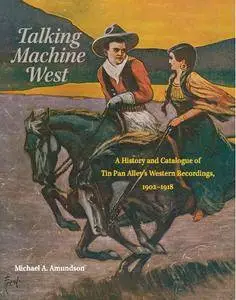Talking Machine West: A History and Catalogue of Tin Pan Alley's Western Recordings, 1902–1918 (American Popular Music Series) by Michael A. Amundson
2017 | ISBN: 080615604X | English | 208 pages | PDF | 80 MB
2017 | ISBN: 080615604X | English | 208 pages | PDF | 80 MB
Many associate early western music with the likes of Roy Rogers and Gene Autry, but America’s first western music craze predates these “singing cowboys” by decades. Written by Tin Pan Alley songsters in the era before radio, the first popular cowboy and Indian songs circulated as piano sheet music and as cylinder and disc recordings played on wind-up talking machines.
The colorful fantasies of western life depicted in these songs capitalized on popular fascination with the West stoked by Buffalo Bill’s Wild West shows, Owen Wister’s novel The Virginian, and Edwin S. Porter’s film The Great Train Robbery. The talking machine music industry, centered in New York City, used state-of-the-art recording and printing technology to produce and advertise songs about the American West.
Talking Machine West brings together for the first time the variety of cowboy, cowgirl, and Indian music recorded and sold for mass consumption between 1902 and 1918. In the book’s introductory chapters, Michael A. Amundson explains how this music reflected the nostalgic passing of the Indian and the frontier while incorporating modern ragtime music and the racial attitudes of Jim Crow America. Hardly Old West ditties, the songs gave voice to changing ideas about Indians and assimilation, cowboys, the frontier, the rise of the New Woman, and ethnic and racial equality.
In the book’s second part, a chronological catalogue of fifty-four western recordings provides the full lyrics and history of each song and reproduces in full color the cover art of extant period sheet music. Each entry also describes the song’s composer(s), lyricist(s), and sheet music illustrator and directs readers to online digitized recordings of each song.
Gorgeously illustrated throughout, this book is as entertaining as it is informative, offering the first comprehensive account of popular western recorded music in its earliest form.



